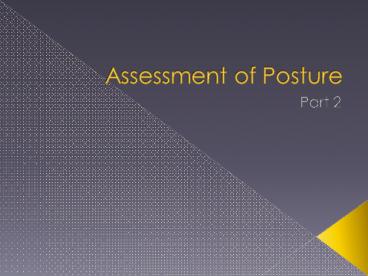Assessment of Posture - PowerPoint PPT Presentation
1 / 14
Title:
Assessment of Posture
Description:
Diastematomyelia (hairy patches) Pigmented lesions. Caf au lait spots. neurofibromatosis ... Patient flexes head and straightens the leg with foot dorsiflexed ... – PowerPoint PPT presentation
Number of Views:376
Avg rating:3.0/5.0
Title: Assessment of Posture
1
Assessment of Posture
- Part 2
2
Patient History
- Neurologic symptoms?
- Nature, extent, type, and duration of pain?
- Exacerbating activities or positions?
- Difficulty breathing?
- Dominant hand?
- Previous treatment? Did it help?
3
Observation
- Body type
- Ectomorph
- Mesomorph
- Endomorph
4
Observation
- Anterior view
- Head straight on shoulders
- Shoulders level
- Clavicles/AC joints
- Sternum ribs
- Waist angles arm positions
- Carrying angles
5
Observation
- Anterior view
- Iliac crests
- ASIS
- Patellae
- Knees
- Fibular heads
- Malleoli level
- Arches
- Planus
- Cavus
- Feet angle
- Bony bowing
6
Observation
- Anterior view (cont.)
- Diastematomyelia (hairy patches)
- Pigmented lesions
- Café au lait spots
- neurofibromatosis
7
Observation
- Lateral view
- Alignment
- Lateral line of reference
- Forward head
- Curvatures normal?
- Rounded shoulders
- AC/ear relationship
- Muscle tonus
8
Observation
- Lateral view
- Chest deformities
- Pectus carinatum
- Pectus excavatum
- Pelvic angle normal (30)
- Knee position
9
Observation
- Posterior view
- Shoulders level
- Spines inferior angles of scapula congruent
- Spine alignment
- Rib symmetry
- Arms equidistant and equally rotated
- PSIS level
- Gluteal folds level
10
Observation
- Posterior view
- Knee joints level
- Achilles tendon angles
- Heels straight
- Tibia or femur bowed?
11
Observation
- Forward flexion
- Rib cage asymmetry?
- Spinal musculature asymmetry?
- Kyphosis?
- Lumbar spine movement normal?
- Restriction to movement?
12
Examination
- Leg length measurement
- Clear the hips first
- Structural
- ASIS to the medial malleolus
- Functional
- Umbilicus to medial malleolus
- Differences of 1-1.3 cm considered WNL
- Some studies indicate .5 cm may cause symptoms
13
Examination
- Slump test
- Patient flexes head and straightens the leg with
foot dorsiflexed - AT gently eases patient forward to increase the
stretch on the sciatic nerve - Back pain in flexion that is eased with head
extension and/or plantarflexion may indicate a
nerve root irritation
14
Lab Time!




























![[PDF] Orthopedic Physical Assessment (Orthopedic Physical Assessment (Magee)) 6th Edition Full PowerPoint PPT Presentation](https://s3.amazonaws.com/images.powershow.com/10084240.th0.jpg?_=20240723111)


